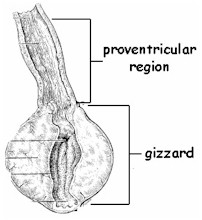Tag: Gastrin
-
Pulmonary neuroendocrine cells
Neuroendocrine cells are cells that receive neuronal input (through neurotransmitters released by nerve cells or neurosecretory cells) and, as a consequence of this input, release messenger molecules (hormones) into the blood. In this way they bring about an integration between the nervous system and the endocrine system, a process known as neuroendocrine integration. An example of a neuroendocrine cell is a cell…
-
Enterochromaffin (EC) cells aka Kulchitsky cells
Enterochromaffin (EC) cells (also known as Kulchitsky cells) are a type of enteroendocrine cell, and neuroendocrine cell. They reside alongside the epithelium lining the lumen of the digestive tract and play a crucial role in gastrointestinal regulation, particularly intestinal motility and secretion. They were discovered by Nikolai Kulchitsky. EC cells modulate neuron signalling in the enteric nervous system (ENS) via the secretion of the neurotransmitter serotonin and other peptides.…
-
Gastrin-releasing peptide aka GRP
Gastrin-releasing peptide, also known as GRP, is a neuropeptide, a regulatory molecule that has been implicated in a number of physiological and pathophysiological processes. Most notably, GRP stimulates the release of gastrin from the G cells of the stomach. The gene from which GRP is derived encodes a number of bombesin-like peptides. Its 148-amino acid preproprotein, following cleavage of a signal peptide, is further processed to…
-
Bombesin (and a wee bit of ranatensin)
Bombesin is a 14-amino acid peptide originally isolated from the skin of the European fire-bellied toad (Bombina bombina) by Vittorio Erspamer et al. and named after its source. It has two known homologs in mammals called neuromedin B and gastrin-releasing peptide. It stimulates gastrin release from G cells. It activates three different G-protein-coupled receptors known as BBR1, -2, and -3. It also activates these receptors in the brain. Together with cholecystokinin, it is the second major source of negative feedback signals that stop…
-

The lactating birds and the bees (gastrin, pepsin, etc)
Crop milk is a secretion from the lining of the crop of parent birds that is regurgitated to young birds. It is found among all pigeons and doves where it is referred to as pigeon milk. An analog to crop milk is also secreted from the esophagus of flamingos and the male emperor penguin. Description Crop milk bears little physical resemblance to mammalian milk. Crop milk is a…
-

Tetragastrin is commonly used in scientific research to induce panic attacks
CCK-4 reliably causes severe anxiety symptoms when administered to humans in a dose of as little as 50μg
-

A tetrapeptide is a peptide, classified as an oligopeptide, since it only consists of four amino acids
Examples of tetrapeptides are: See also Hormones Categories: From Wikipedia where this page was last updated July 2, 2022
-
Somatostatin
Not to be confused with Somatocrinin or Somatomedin. Somatostatin, also known as growth hormone-inhibiting hormone (GHIH) or by several other names, is a peptide hormone that regulates the endocrine system and affects neurotransmission and cell proliferation via interaction with G protein-coupled somatostatin receptors and inhibition of the release of numerous secondary hormones. Somatostatin inhibits insulin and glucagon secretion. “somatostatin”. Encyclopædia Britannica. Encyclopædia Britannica Online. Encyclopædia Britannica Inc., 2016. Web. 04 mag. 2016…
-

Calcitonin
Calcitonin is a 32 amino acid peptide hormone secreted by PARAFOLLICULAR CELLS (also known as C cells) of the thyroid (or endostyle) in humans and other chordates in the ultimopharyngeal body. It acts to reduce blood calcium (Ca2+), opposing the effects of PARATHYROID HORMONE (PTH). Its importance in humans has not been as well established as its importance in other animals, as its function is usually not significant in the…
-
Oxytocin
Oxytocin (Oxt or OT) is a peptide hormone and neuropeptide normally produced in the hypothalamus and released by the posterior pituitary. Gray’s Anatomy: The Anatomical Basis of Clinical Practice (41 ed.). Elsevier Health Sciences. 2015. p. 358. ISBN 978-0-7020-6851-5. It plays a role in social bonding, reproduction, childbirth, and the period after childbirth. Audunsdottir K, Quintana DS (2022-01-25). “Oxytocin’s dynamic role across the lifespan”. Aging Brain: 100028. doi:10.1016/j.nbas.2021.100028. ISSN 2589-9589. S2CID 246314607. Leng G, Leng RI (November 2021). “Oxytocin: A…
-
Cholecystokinin aka pancreozymin notes
History Structure Function Gastrointestinal Digestion Satiety The effects of CCK vary between individuals. For example, in rats , CCK administration significantly reduces hunger in adult males, but is slightly less effective in younger subjects, and even slightly less effective in females. The hunger-suppressive effects of CCK also are reduced in obese rats. Fink H, Rex A, Voits M, Voigt…
-
Ghrelin or lenomorelin
History and name Gene, transcription products, and structure Ghrelin cells Alternative names Location Features Function and mechanism of action Blood levels Ghrelin receptor Locations of action Glucose metabolism Sleep Reproductive system Fetus and neonate Anorexia and obesity Disease management Gastric bypass surgery See also External links Look up ghrelin in Wiktionary, the free dictionary. Hormones Peptides: neuropeptides Appetite…
-
Gastrin-releasing peptide aka GRP and Pro-Gastrin-Releasing-Peptide aka Pro-GRP (and something called PreProGRP?)
Gastrin-releasing peptide, also known as GRP, is a neuropeptide, a regulatory molecule that has been implicated in a number of physiological and pathophysiological processes. Most notably, GRP stimulates the release of gastrin from the G cells of the stomach. Function GRP is also involved in the biology of the circadian system, playing a role in the signaling of light to the master circadian oscillator in…
NOTES
- 🧬 Disease Table with Low Sodium Connection
- 🧂 Sodium Reduction and Sodium Replacement: A History of Reformulation and Exploding Diseases, Including Many Diseases Unheard of Before Deadly Sodium Policies
- 🧂 The DEADLY 1500 mg Sodium Recommendation predates the WHO’s formal global sodium reduction push by nearly a decade (and it’s even worse than that)
- 🧬 What Is Beta-Glucuronidase?
- When Sugar Was Salt: Crystalline Confusion and the Covenant of Sweetness
Tags
ADAM ASPARTAME Birds Blood Bones Brain Bugs Cancer Columba Cows crystallography Death Death cults Eggs Etymology Gastrin Gold Growth hormone History Hormones Insulin Liver Mere Perplexity Metal Monkey Business Mythology Paracetamol Plants Poison Pregnancy Protein Religion Reproduction Rocks Salt Slavery Snakes Sodium the birds and the bees Thiocyanate Tobacco Tylenol Underworld Venom zinc



